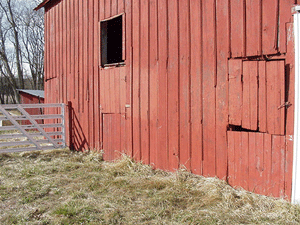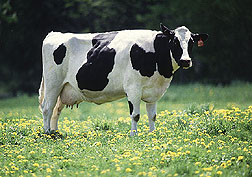Our home is in farm country. Should we be worried about our drinking water?
Answering this question depends on many factors such as soil types, what types and amounts of pesticides and fertilizers the farmer may be using, depth and age of your well, whether or not you live in a karst region or there is fractured bedrock or limestone close to the land surface, water table level, among other factors. Contaminants that may be associated with agriculture include nitrate (sometimes from nitrogen fertilizer or manure) and pesticides. Bacteria may be a concern in areas of livestock operations and when manure is misapplied to fields, and if there are septic system problems.
 A
good question to ask is what contaminants are typically found in wells
in rural areas of Indiana. In 1993 a state-wide testing program of 9,143
water samples from private wells indicated that 4.5% of wells had levels
of nitrate over 10 ppm (the drinking water standard), with 8.4% of wells
showing nitrate between 3.0 and 10 ppm. Pesticides and their breakdown
products were tested for in more than 8000 wells, and detected in more
than 7% of them. Pesticide levels that may be above the drinking water
standard (3 ppb for triazines and 2 ppb for acetanilides) occurred in
less than 2% of wells tested. In the case of both nitrate and pesticides,
old wells, shallow wells, and surface water supplies were more likely
to have these contaminants compared with newer wells or wells deeper than
50 feet.
A
good question to ask is what contaminants are typically found in wells
in rural areas of Indiana. In 1993 a state-wide testing program of 9,143
water samples from private wells indicated that 4.5% of wells had levels
of nitrate over 10 ppm (the drinking water standard), with 8.4% of wells
showing nitrate between 3.0 and 10 ppm. Pesticides and their breakdown
products were tested for in more than 8000 wells, and detected in more
than 7% of them. Pesticide levels that may be above the drinking water
standard (3 ppb for triazines and 2 ppb for acetanilides) occurred in
less than 2% of wells tested. In the case of both nitrate and pesticides,
old wells, shallow wells, and surface water supplies were more likely
to have these contaminants compared with newer wells or wells deeper than
50 feet.
These numbers suggest typical contaminant levels in rural private wells. However, to find out if you should be concerned, you need to have your own water tested.
Your primary defense of your water well is to do everything that YOU can do on your own property first. Completing the Home*A*Syst program is an excellent and time effective strategy to accomplish this. In addition, test your water annually for contaminants. Once you have done all that you can on your own property and you are still concerned, you might talk with the farmer about your concerns of protecting your water supply. There are many best management practices (known as BMP's) that the farmer may or may not be practicing on the fields next to your well. You could refer the farmer to the Home*A*Syst companion, Indiana Farmstead Assessment System. If you discover that your well water is contaminated with pesticides or nitrates, or is at a high risk from surface contaminants due to soil type, age, or depth, you could encourage the farmer to:
- Discontinue the use of any pesticides that have a Ground Water Advisory label.
- Use a nutrient management plan to help prevent leaching of unutilized fertilizer. Your local Natural Resources Conservation Service or Extension Office can assist farmers with putting a nutrient management plan together.
 In
addition:
In
addition:
If your well is very old, shallow, or an unsafe distance from potential
sources of contamination, consider drilling a deep well with the greatest
separation distance possible from all sources of contamination.
Links to water quality agencies and organizations in Indiana and elsewhere can be found here.
For
more information contact Jane Frankenberger
(frankenb@purdue.edu)